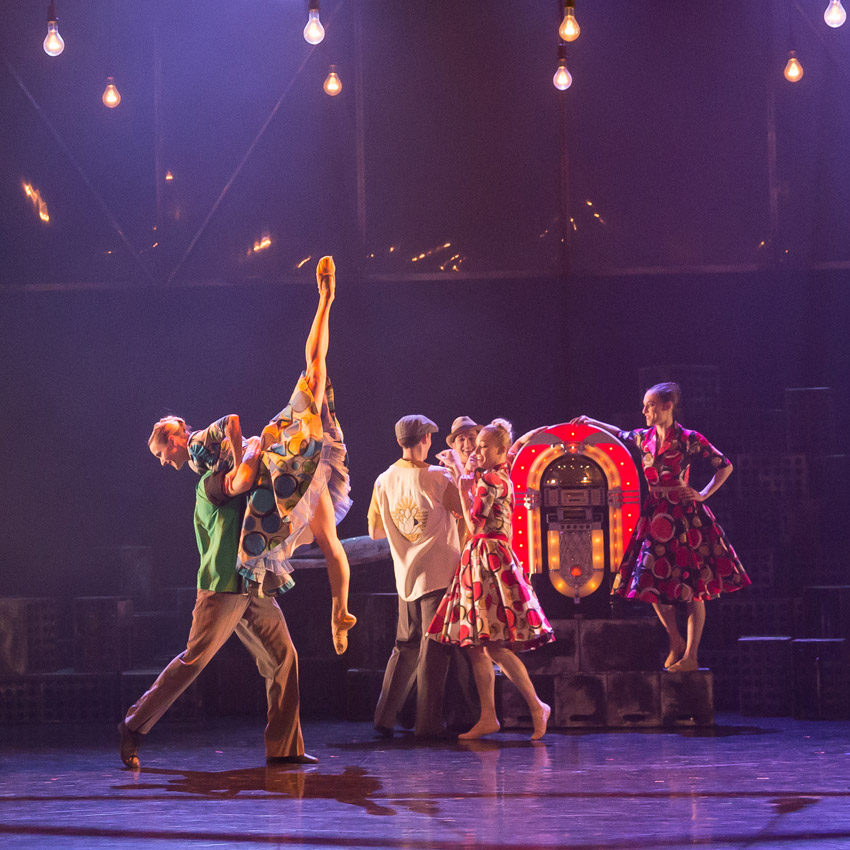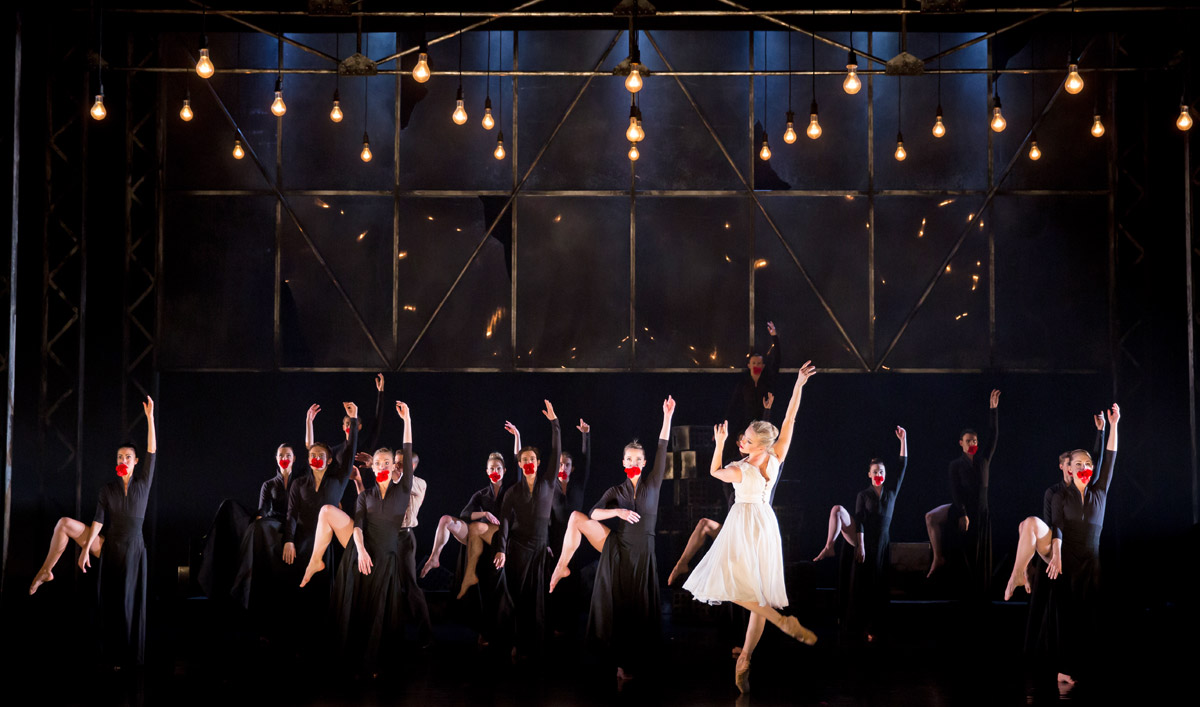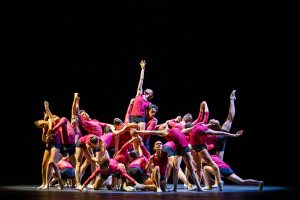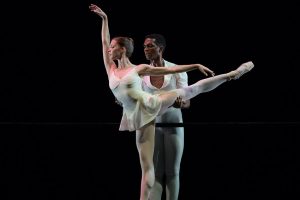
© Andy Ross. (Click image for larger version)
Scottish Ballet
A Streetcar Named Desire
Washington, Kennedy Center Opera House
28 May 2015
www.scottishballet.co.uk
www.kennedy-center.org
“They told me to take a street-car named Desire, and then transfer to one called Cemeteries and ride six blocks and get off at – Elysian Fields!” So uttered a delicate and delicately dressed Blanche DuBois, who found herself one steamy day in a dilapidated neighborhood of New Orleans, clutching in hand a piece of paper with the address of her sister’s house. And so the main heroine of Tennessee Williams’ 1947 classic “A Streetcar Named Desire” charts, in one sentence, the direction of her own tragic destiny. The names of the streetcars she is about to board acquire a richly symbolic meaning.
The heartbreaking downward spiral of Blanche DuBois and the ultimate price of her desires found a potent, compelling illustration in a theater-dance adaptation of Williams’s famous play presented by Scottish Ballet at the Kennedy Center Opera House in May. This was the Glasgow-based troupe’s first appearance at the Kennedy Center.
This smartly-conceived and expertly-developed translation of prose to movement was a result of an artistic partnership between film and theater director Nancy Meckler and choreographer Annabelle Lopez Ochoa, well-known in Washington for her collaboration with the Washington Ballet. With plenty of masterly touches, the creators untangled the narrative of the play, straightening out the timeline and putting the events, including Blanche’s rosy reminiscences and harrowing flashbacks, in chronological order. As the story unfolds, the entire life of Blanche flashes before our eyes: from blissful days as a young happy bride spinning in a gentle waltz with her loving husband to her final, wretched promenade to a mental clinic under the sinister watch of her brother-in-law, Stanley Kowalski.

© Andy Ross. (Click image for larger version)
Niki Turner’s ingenious sets gave this production a menacing, darkly atmospheric look. In one of the first scenes, Blanche’s beautiful white-portico mansion (shown as a huge black-and-white photograph) spectacularly turns into a dusty pile of building blocks. Manipulated and arranged by the ensemble dancers, these blocks will serve as props and set pieces for the actions to come. At one point, they become a mournful pedestal for Blanche’s dead newlywed husband who committed suicide, unable to live through his shame and her rejection when the unsuspecting and unforgiving Blanche found him having a love relationship with another man. In another memorable scene, the blocks form a commuter train in which Blanche flees the town of Laurel, thrown out by the authorities for her unglamorous escapades with numerous suitors in a hotel-turned-brothel as well as for seducing an underage boy. The cramped quarters of the Kowalskis look appropriately dreadful and claustrophobic, complete with a bare bed and a white bathtub to be used by its tenants to calm nerves and cool anger. In this dismal place, the lonely and penniless Blanche finds herself in desperate hope for a place to live, burning with desire to be accepted and loved.
Poor Blanche! If she had only known that she was wandering into a lion’s den and her fake gallantry and faded finery would make this lion snarl and snap with violent rage!
Indeed, there was plenty of ferocious energy in Erik Cavallari’s Stanley Kowalski during the opening night performance. Broad and muscular, with brooding macho charisma, the Italian-born dancer dominated every scene he was in. His sheer physical power, coupled with his stellar acting, was so gripping that I couldn’t help but draw parallels of his performance with that of Marlon Brando in the iconic 1951 screen adaptation of the play.
At first glance, the sturdy and robust Eve Mutso seemed like an unfitting choice for the role of a fragile, delusional Blanche; yet from the opening image of her heroine trembling with anxiety and terror in the pool of bright light, Mutso unearthed a poignant portrayal of a damaged woman whose terrible losses put her on a path of self-destruction. Haunted by demons of her past and desperately hiding her sordid history, Mutso’s Blanche was as poignant as she was pitiful, bravely trying to reclaim her dignity and putting up a fight with her brutal brother-in-law only to succumb to his ruthless cruelty and vengeance.
It was both fascinating and disheartening to see Blanche’s face-off with Stanley, which forms the focal point of this superb production. The hallucinating and always-drunken Blanche, with her pointedly refined manners, didn’t stand a chance against her sister’s working-class husband, who perceived her not only as an uninvited guest, but as an intruder who was about to wreck his family nest. With agonizing viciousness, Stanley fought for his territory and ultimately turned Blanche into a hostage and a victim.

© Andy Ross. (Click image for larger version)
As Stella, the gentle and petite Sophie Martin looked so youthful and defenseless that one could not help but feel immediate sympathy for her character. At the end, she came across as an ultimate survivor in this horrid story as well as the protector of her growing family. Her love duet with Stanley, performed after he violently attacked her and then famously cried her name (the only spoken words in this staging), was the emotional and choreographic highlight of the entire production. Watching them dance, it felt as if for a moment Cavallari had abandoned his anti-hero and become a Romeo swirling with his beloved Juliet in a vortex of inexorable passion. I thought the audience stopped breathing, witnessing in stunned silence their exalted marital bliss.
Overall the production hit all the right targets, yet there were a few sour moments. The scenes depicting Blanche’s youth in the first act were a bit overstretched; the relentless ghostly appearances of her dead husband over the course of the show didn’t add much to the story and often felt like a distraction; and the Spanish flower market, at the ballet’s finale, picturing legions of black-clad women with red flowers in their teeth, felt somewhat clichéd.
This production would not be the same without the evocative, jazz-infused score and fascinating sound effects created by Peter Salem. Played live by the Opera House under the baton of Richard Honner, the music aptly reflected the wide-ranging moods of the story from happiness and optimism to unsettling fear and gloomy despair, adding an extra layer of emotional nuance to this brilliant piece of theatrical dance.

















You must be logged in to post a comment.